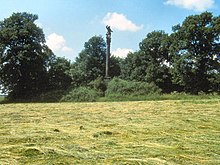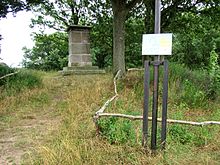Prussian columns
The Prussian Columns are two more than 15 m high monuments that were erected in the years 1854 and 1855 by order of the Prussian King Friedrich Wilhelm IV. On the southeast coast of the island of Rügen near Neukamp and Groß Stresow. Both localities are now districts of the municipal Putbus, which is free of charge . The memorial near Neukamp was inaugurated on October 15, 1854, and that near Groß Stresow exactly one year later, on the 60th birthday of Friedrich Wilhelm IV. Parts of the pedestals and especially the column drums were knocked out of one of the largest boulders in northern Germany, the Great Stone near Nardevitz on Rügen's Jasmund peninsula . This boulder, which is still impressive today and protruding more than three meters from the ground, was largely destroyed. (see also: boulders around and on Rügen )
The monuments were intended to commemorate the landings of Brandenburg and later Prussian troops in 1678 and 1715 and demonstrate Prussia's claim to power over the southern Baltic region. Rügen, which had belonged to Swedish Pomerania since the Peace of Westphalia in 1648 , was temporarily snatched from Swedish rule, but then ceded back to Sweden through corresponding peace agreements.
Historical background
Neukamp
In the Swedish-Brandenburg War (1674–1679), Friedrich Wilhelm , the "Great Elector" of Brandenburg, allied with the Danish King Christian V , succeeded in conquering the island in September 1678 through an invasion of Rügen . Under the leadership of Admiral Nils Juel, the Danes landed on the Wittow peninsula on September 13, 1678 and, after the expulsion of the weak Swedish garrison on Wittow, built a hill at the transition to the Schaabe near today's Juliusruh , which is still well preserved as a ground monument (from the south coming directly at the entrance sign).
The Great Elector landed on the same day with the Brandenburg troops (7000-8000 men) under the leadership of Field Marshal Derfflinger from Greifswald via the Greifswalder Bodden with his fleet, consisting of 350 sailing ships and 150 rowing boats, on the south-east coast of Rügen near Neukamp. The Swedes entrenched there under Koenigsmark were pushed back to Altefähr to the ferry station there and then to Stralsund and Stralsund was besieged from the mainland and from the island. The fortress capitulated on October 12, 1678, cut off from supplies and reinforcements.
The hill near Neukamp, which is still in good condition, is located directly behind the monument.
In the Peace of Saint-Germain on June 29, 1679, Brandenburg had to return Western Pomerania, and with it Rügen, to Sweden.
Great Stresow
During the Great Northern War (1700–1721), the Prussian King Friedrich Wilhelm I , allied with the Danish King Friedrich IV , landed on November 15, 1715 with his troops (20,000–24,000 men) under the leadership of the " old Dessauer " Groß Stresow and expelled in the Battle of Stresow the Swedes, which under the leadership of their King Charles XII. stood, from the island of Rügen over the Strelasund to Stralsund, which had been besieged by Danes and Prussians for a long time, but had so far received Swedish supplies via Rügen. After another siege, the Swedes enclosed in the city of Stralsund surrendered on December 23, 1715, with Karl XII. could only escape across the Baltic Sea in a fishing boat. Nevertheless, as a result of the peace treaty of August 14, 1719, Prussia had to return the island to Sweden.
Erection of the monuments
The designs for the monuments commissioned by Friedrich Wilhelm IV come from the architect Friedrich August Stüler . The sculptor Wilhelm Stürmer made the statues. These are each approx. 3.40 m high and, like the capitals , on which the statues then stand on the granite pillars, are made of Saxon sandstone . The total cost at that time was exactly 6,815 Reichstaler .
Recent history to the present
In 1985, 130 years after the monuments were erected, experts from VEB Denkmalpflege Dresden questioned the stability of the pillars during an investigation. After a crisis meeting on September 11, 1990 in Putbus, a Berlin master stonemason and restorer was commissioned to dismantle both monuments. At the end of November 1991 both monuments were dismantled and the column drums, capitals and statues were transported to the workshop of the master stonemason in Berlin-Pankow . Originally, copies of the column drums, capitals and statues were to be made, as "repair" was not recommended due to the severe damage to the original parts. The column drums were once connected to one another in the middle with iron pins. Due to the strong corrosion of many decades on these iron connecting pieces, the granite had been partially blown up, which had primarily led to the risk of collapse through cracks and splitting. But the statues have also been so badly eroded by the weather and lightning strikes that some contours have already been irretrievably destroyed. The material for any copies to be made, i.e. Elbe sandstone for the capitals and statues and Bornholm granite - which is what the boulder near Nardevitz is made of, from which the six five-tonne column drums were once beaten - would be easy to obtain.
Further damage occurred during dismantling. The commissioned master stonemason used hammer drills to loosen the iron pins that held the individual parts together from the granite. In some cases, large pieces were pried off at the respective ends of the drums. The drill holes on the drum ends clearly demonstrate this. The transport to Berlin did not go smoothly either, because the statue of Friedrich Wilhelm I from Groß Stresow broke in the area of the legs. The head also came off and was already glued back on by the master stonemason. Due to the persistent lack of money in the Rügen district , which is the owner of the monuments, hardly any work was done on the project in the following years, with the exception of the completion of a capital. Here z. For example, it also plays a role that the making of copies is less important than the restoration of original monuments when granting funding.
A step-by-step plan adopted by the “Prussian Columns” working group in March 2003 provided for the following: First the pedestals of both monuments, then the column drums and finally the statues were to be restored to their original place by 2010. Because parts of the pedestals at Neukamp were also disorganized around the locations of the monuments. The idea behind this step-by-step plan was that a visible start had to be made in order to attract sponsors and increase the willingness to donate. When looking for sponsors for this project, the Rügen district council president z. B. even written to the royal houses of Denmark and Sweden.
In April 2004 it was decided to bring the original parts back to the island by the 150th anniversary of the inauguration of the first Prussian column, i.e. by October 15, 2004. However, this return transport alone failed again due to financing problems, as only a symbolic amount of 500 euros was entered in the district budget for the two monuments.
In October 2004 the 3.30 m high pedestal of the Prussian Column near Groß Stresow was restored. As the result suggested previous soil surveys, the ground was in the construction of this monument to a depth of 5.80 m with stones of a previously located at this point megalithic tomb been solidified. This was confirmed again during the work on the foundation. The necessary approx. 20,000 euros were raised from donations by the Kreissparkasse Rügen and the German Foundation for Monument Protection .
On September 2, 2005, the original parts were transported unprocessed from Berlin to Putbus and since then have been presented to the public in an open space on Alleestrasse, near the Circus. Here, too, an accident happened to the master stonemason. The already broken statue of Friedrich Wilhelm I fell over in the workshop. The braid, the nose, parts of the hat brim and the arm broke off. After almost 15 years, all parts are now back on Rügen to enable an independent assessment by experts on site. An information board here indicated the history of the two monuments and encouraged donations for their reconstruction.
On April 28, 2006, a symposium on the restoration and restoration of both monuments was held in Putbus. The organizer of the symposium was the State Office for Culture and Monument Preservation Mecklenburg-Western Pomerania . The following possibility of restoration with the original parts emerged: The original parts are drilled through in the middle of the longitudinal axis. The column should then be erected piece by piece after the respective damage has been repaired, the loads of the respective part being absorbed with the help of solid stainless steel pipes inserted through the bore . Accordingly, each part of the column only bears its own weight, the internal and invisible stainless steel construction with a new foundation, however, the total loads. This solution is controversial, but would cost (only) around 80,000 euros per column. In view of a budget deficit of around 9.5 million euros in the Rügen district at the end of 2007, the necessary money would not be available in 2008 either.
In the summer of 2008 at least the pedestal in Neukamp was restored - without considering the solution proposed at the symposium.
On July 10, 2012, the Neukamp pillar was rebuilt by the Mühlhausen monument preservation company based on an engineering concept by Büro für Baubaus GmbH . The figure of the Great Elector was put on on August 22, 2012.
On the 300th anniversary of the Battle of Groß Stresow in November 2015, the column in Groß Stresow was also rebuilt after the restoration. She received a new statue made by the Dresden stonemason and sculptor Sven Schubert (* 1965). The original figure, which was damaged several times, was built in 2014 at the house of traitors in Groß Stresow.
Web links
- Geographical coordinates of the two monuments:
- near Neukamp: 54 ° 19 ′ 8.2 ″ N , 13 ° 27 ′ 42.7 ″ E
- at Groß Stresow: 54 ° 21 ′ 24.7 ″ N , 13 ° 34 ′ 18.7 ″ E
- Literature on Prussian Columns in the State Bibliography MV (Neukamp)
- Deficiencies in the restoration of the monument
- Literature on Prussian columns in the state bibliography MV (Groß Stresow)
- Association for the Preservation of the Prussian Columns
credentials
- ↑ Prussian Column on Rügen complete . In: Neues Deutschland , 23 August 2012.
- ↑ Dresden stone sculptors at home with the stars ( memento of the original from November 17, 2015 in the Internet Archive ) Info: The archive link was automatically inserted and not yet checked. Please check the original and archive link according to the instructions and then remove this notice.
- ↑ Groß Stresow celebrates the renovated Prussian Column ( memento from November 17, 2015 in the Internet Archive ), NDR from November 15, 2015, accessed on November 16, 2015












